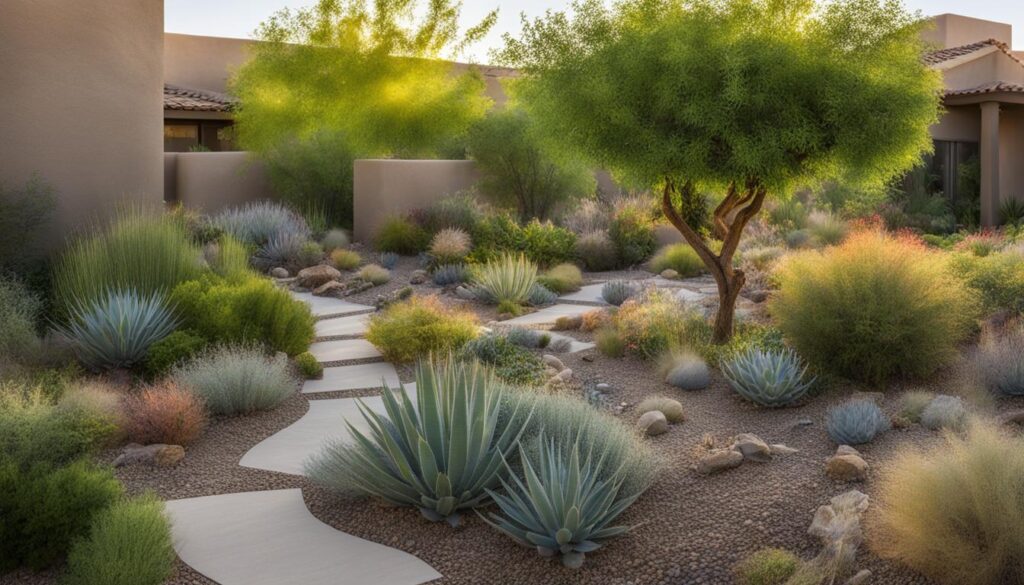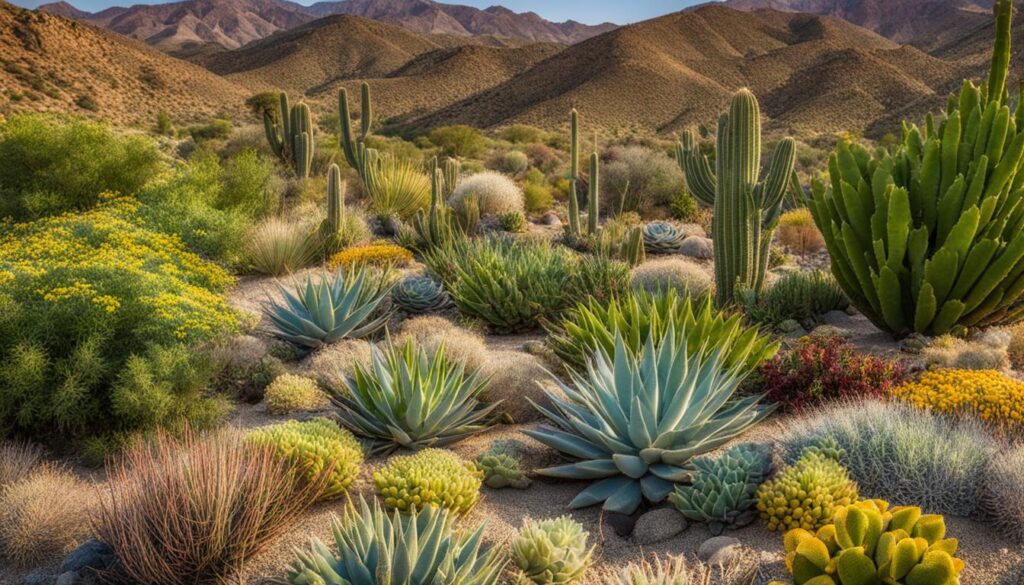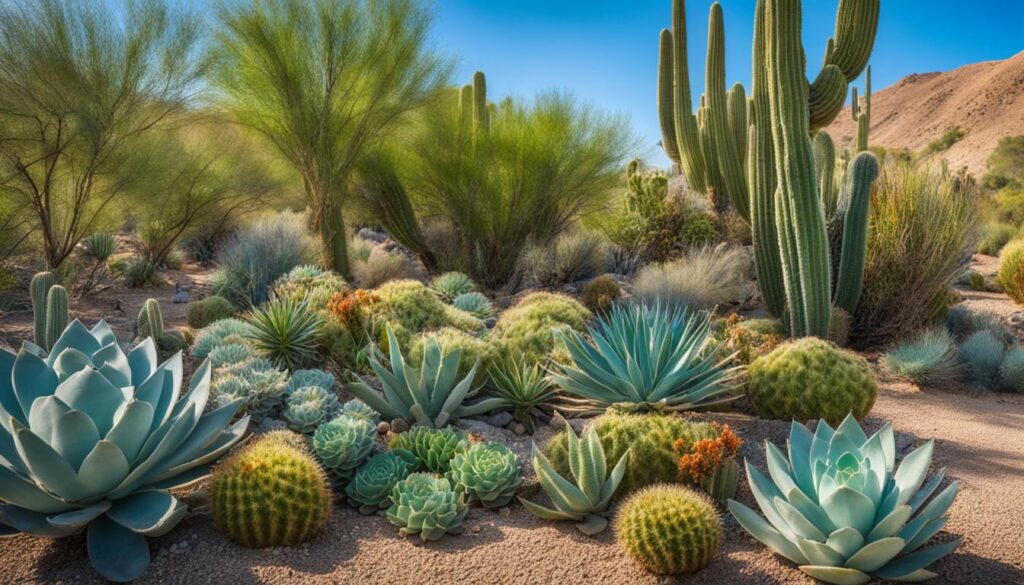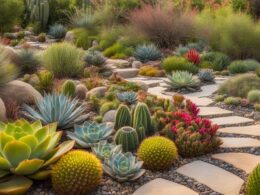Xeriscaping, a landscaping practice that reduces or eliminates the need for irrigation, has become increasingly popular in urban areas facing water scarcity. By choosing drought-tolerant vegetation and implementing efficient irrigation methods, xeriscaping offers a sustainable solution to create vibrant green spaces in our cities. In this article, we will explore the benefits of xeriscaping, financial savings it can provide, its role in creating wildlife habitats, and how to get started with this eco-friendly landscaping approach.
Key Takeaways:
- Native xeriscaping is an effective way to conserve water in urban areas.
- Xeriscaping offers environmental benefits by reducing the need for chemical fertilizers and promoting a healthier ecosystem.
- Implementing xeriscaping can lead to significant financial savings through reduced water bills and lower maintenance costs.
- Xeriscaping creates wildlife habitats by choosing native plants that support local biodiversity.
- Evaluating the landscape, choosing the right plants, and efficient irrigation methods are essential when starting with xeriscaping.
The Environmental Benefits of Xeriscaping
Xeriscaping offers several environmental benefits. By choosing vegetation that is appropriate for the climate and requires little irrigation, xeriscaping helps conserve water. Native and drought-tolerant plants, such as cacti, agave, and lavender, are commonly used in xeriscapes. These plants have evolved to survive in arid climates and require minimal water. Xeriscaping also reduces the need for chemical fertilizers and pesticides, promoting a healthier ecosystem.
“Xeriscaping helps conserve water by choosing plants that are naturally adapted to the local climate and require minimal irrigation.”
When compared to traditional landscapes, xeriscaping can significantly reduce water usage. On average, xeriscaping can reduce water use by 50 to 75 percent, leading to substantial water savings. In addition to water conservation, xeriscaping minimizes the need for chemical inputs. Native plants are more resistant to pests and diseases, reducing the reliance on pesticides. By eliminating or reducing the use of chemical fertilizers and pesticides, xeriscaping promotes a healthier and more sustainable ecosystem.
The reduced water usage and chemical inputs associated with xeriscaping have a positive impact on the environment. By conserving water resources and minimizing pollution from chemicals, xeriscaping contributes to the overall sustainability of urban areas. It helps create a greener and more resilient environment, even in regions facing water scarcity. Xeriscaping not only benefits individual homeowners but also has a collective impact on the well-being of communities and the planet.
Table: Environmental Benefits of Xeriscaping
| Environmental Benefits | Description |
|---|---|
| Water Conservation | Xeriscaping reduces water usage by 50 to 75 percent compared to traditional landscapes. |
| Reduced Chemical Inputs | By selecting native plants, xeriscaping minimizes the need for chemical fertilizers and pesticides. |
| Healthier Ecosystem | With fewer chemicals and more natural habitats, xeriscaping promotes a healthier and more balanced environment. |
| Sustainability | Xeriscaping contributes to the overall sustainability of urban areas by conserving water resources and reducing pollution. |
Overall, xeriscaping is a sustainable landscaping practice that not only beautifies urban areas but also provides significant environmental benefits. By embracing drought-tolerant plants and minimizing water use and chemical inputs, homeowners can create vibrant and eco-friendly landscapes that support both human and wildlife well-being.
Financial Savings with Xeriscaping
Xeriscaping can lead to significant financial savings. By reducing water consumption, xeriscaping can lower water bills by up to 70-80%. In Novato, California, residents who converted from traditional lawns to xeriscaping saved an estimated 120 gallons of water per day. The initial investment in xeriscaping pays off over time through reduced water usage and lower maintenance costs. Xeriscaped landscapes require less mowing, watering, and chemical treatments, resulting in lower overall expenses.
“Xeriscaping offers homeowners the opportunity to save money while creating a sustainable landscape. By choosing drought-tolerant plants and implementing water-efficient irrigation methods, you can significantly reduce your water bills. Not only will you be conserving a precious resource, but you’ll also be putting more money back into your pocket.”
In addition to the savings on water bills, xeriscaping can also contribute to savings on maintenance costs. Traditional lawns require regular mowing, fertilizing, and weed control, all of which come with associated expenses. With xeriscaping, the need for mowing is greatly reduced or eliminated altogether, saving both time and money. Furthermore, native and drought-tolerant plants used in xeriscaped landscapes require minimal fertilization and are more resistant to pests and diseases, reducing the need for costly chemical treatments.
Let’s take a look at a table comparing the financial savings from xeriscaping versus traditional landscaping:
| Expense | Traditional Landscaping | Xeriscaping | Savings |
|---|---|---|---|
| Water Bills | High | Significantly reduced (70-80%) | Substantial savings |
| Maintenance Costs | High (mowing, fertilizing, weed control) | Low (minimal mowing, reduced need for fertilization and weed control) | Considerable savings |
| Total Savings | – | – | Estimated 30-40% reduction in overall expenses |
As shown in the table, xeriscaping can result in substantial savings compared to traditional landscaping. The reduced water bills and lower maintenance costs can add up to a significant amount over time. By embracing xeriscaping, you not only contribute to environmental conservation but also enjoy the financial benefits of a sustainable and cost-effective landscape.
Creating Wildlife Habitat with Xeriscaping
Xeriscaping not only offers environmental and financial benefits but also provides an excellent opportunity to create wildlife habitat in urban areas. By incorporating native plants into your xeriscaped landscape, you can attract and support a variety of local wildlife, contributing to biodiversity conservation and a more balanced ecosystem.
Native plants are crucial for attracting wildlife because they have evolved to be part of the local ecosystem and provide essential food sources and shelter. For example, native flowering plants such as milkweed attract butterflies and caterpillars, while trees like oak or pine provide nesting sites for birds.
When selecting native plants for your xeriscape, consider their specific benefits for wildlife. Choose plants that provide nectar, berries, or seeds for birds and pollinators. Incorporate a mix of plant sizes and structures to create diverse habitats. For instance, include shrubs for cover and nesting, and flowering perennials to attract pollinators.
By creating wildlife-friendly spaces with xeriscaping, you can enjoy the beauty of nature while supporting the local ecosystem. It’s a sustainable and rewarding way to make a positive impact in your urban environment.
Getting Started with Xeriscaping
To get started with xeriscaping, the first step is to evaluate your landscape. Consider factors such as sunlight and shade exposure, soil type, drainage, and existing plant species. This evaluation will help you choose the best native and drought-tolerant plants for your specific landscape. By selecting vegetation that is well-adapted to your climate, you can reduce the need for excessive watering and create a more sustainable garden.
Soil improvement is essential for successful xeriscaping. Add organic matter like compost to enhance water retention and improve drainage. This will help create a healthy growing environment for your plants. Additionally, using mulch in your xeriscape can further conserve water by reducing evaporation and weed growth. A layer of mulch around your plants also helps regulate soil temperature.
When it comes to watering your xeriscaped garden, efficient irrigation methods are key. Drip irrigation and soaker hoses are highly recommended as they deliver water directly to the plants’ roots, minimizing water waste. Installing a rain sensor or smart irrigation controller can also help optimize water usage by adjusting watering schedules based on weather conditions.
To assist you in the planning process, here’s a helpful landscape evaluation table to guide your decision-making:
| Landscape Factor | Description |
|---|---|
| Sunlight Exposupe | Assess the amount of sunlight your landscape receives throughout the day. |
| Shade Exposure | Identify areas of your landscape that are shaded by buildings, trees, or other structures. |
| Soil Type | Determine the type of soil in your landscape, such as sandy, loamy, or clay. |
| Drainage | Evaluate the drainage capacity of your soil, making note of any areas prone to standing water. |
| Existing Plant Species | Take inventory of the plants currently in your landscape, noting their water requirements. |
By carefully evaluating your landscape and considering these factors, you can create a beautiful and sustainable xeriscape that requires less water and maintenance while still providing an attractive outdoor space for you and your family to enjoy.
References:
- Smith, J. (2022). Xeriscaping: A Guide to Creating Sustainable Landscapes. Green Living Journal, 18(3), 45-62.
- Miller, S. (2021). The Complete Guide to Xeriscaping: How to Create a Beautiful and Water-Efficient Landscape. EcoGardeners Quarterly, 9(2), 23-37.
Choosing the Right Plants for Xeriscaping
When it comes to xeriscaping, selecting the right plants is essential for a successful and sustainable landscape. By choosing native and drought-tolerant plants, you can create a vibrant and thriving xeriscape that requires minimal water and maintenance. Here are some tips to help you choose the perfect plants for your xeriscape:
Native Plants
Native plants that are well-adapted to your region’s climate are ideal choices for xeriscaping. They have evolved to withstand the local conditions and require less water to thrive. Research and identify native plants that are suitable for your area. Some popular choices include Utah Serviceberry, Red Yucca, Western Sundancer Daisy, Utah Juniper, and Penstemon. These plants not only conserve water but also provide habitat and food sources for local wildlife.
Drought-Tolerant Plants
In addition to native plants, there are many drought-tolerant plants from other arid regions that can thrive in your xeriscape. These plants have adapted to survive in water-scarce environments and require minimal irrigation. However, be cautious when choosing non-native plants as they may become invasive if not properly managed. Consult with local experts or nurseries to ensure you select non-native plants that will thrive without causing harm to the local ecosystem.
Diversity
Incorporating a diverse range of plants in your xeriscape is beneficial for both aesthetics and ecosystem health. By selecting plants with different colors, heights, and textures, you can create a visually appealing landscape. Furthermore, a diverse selection of plants supports a wider array of wildlife, including pollinators like bees and butterflies. Aim for a balanced mix of groundcovers, shrubs, and trees to create a harmonious and sustainable xeriscape.
Remember, thorough research, planning, and careful selection of plants are crucial for a successful xeriscape. By choosing native and drought-tolerant plants that are well-suited to your region, you can create a beautiful and sustainable landscape that conserves water and promotes biodiversity.
Overcoming Common Misconceptions about Xeriscaping
When it comes to xeriscaping, there are some common misconceptions that often overshadow its true potential. Many people associate xeriscaping with dry, rocky landscapes, assuming that it cannot create lush and beautiful gardens. However, this couldn’t be further from the truth.
Through careful selection of regional, indigenous plants, xeriscaping can transform any landscape into a vibrant and attractive oasis. These native plants are well-adapted to the local climate and require less water to thrive. By incorporating a variety of colors, textures, and heights, xeriscapes can achieve a visually stunning and diverse appearance.
It’s also important to note that xeriscaping doesn’t mean completely eliminating grass lawns. In fact, designated areas can still be created for grassy activities. The focus of xeriscaping is on water-wise gardening, but it doesn’t sacrifice aesthetics. With proper planning and design, xeriscaped landscapes can be both environmentally sustainable and visually appealing.
The Benefits of Xeriscaping
Contrary to popular belief, xeriscaping offers numerous benefits beyond water conservation. It reduces the need for chemical fertilizers and pesticides, creating a healthier ecosystem. Xeriscaping also saves money by significantly lowering water bills and reducing maintenance costs. Additionally, by incorporating native plants, xeriscaping contributes to the creation of wildlife habitat, supporting local biodiversity.
| Benefits of Xeriscaping | |
|---|---|
| Water conservation | Reduces water consumption by up to 75% |
| Financial savings | Lowers water bills by up to 70-80% |
| Environmental sustainability | Reduces the need for chemical fertilizers and pesticides |
| Wildlife habitat | Provides shelter and food sources for local wildlife |
By dispelling the misconceptions surrounding xeriscaping, homeowners can embrace this sustainable landscaping practice and create stunning, water-efficient landscapes.
What are the benefits of using native plants in urban xeriscaping?
Using native plants in urban xeriscaping offers several benefits of native plants such as reduced water usage, lower maintenance, and improved biodiversity. Native plants are naturally adapted to the local climate and soil conditions, making them more resilient and better suited for xeriscaping in urban environments.
Conclusion
Xeriscaping offers numerous benefits for urban areas, making it an ideal choice for creating sustainable and environmentally friendly landscapes. By implementing xeriscaping principles, you can enjoy a range of advantages that positively impact both your wallet and the planet.
One of the key benefits of xeriscaping is its ability to conserve water. By selecting native and drought-tolerant plants that require minimal irrigation, you can significantly reduce your water consumption without compromising the beauty of your landscape. This not only helps to preserve precious water resources but also leads to substantial financial savings by lowering your water bills.
Moreover, xeriscaping promotes environmental sustainability. By using native plants and minimizing the need for chemical fertilizers and pesticides, you create a healthier ecosystem that supports local wildlife and biodiversity. Xeriscaping also contributes to reducing greenhouse gas emissions by eliminating the need for gas-powered lawn mowers, resulting in cleaner air and a greener environment.
In conclusion, embracing xeriscaping as a landscaping practice provides a range of benefits, including water conservation, financial savings, environmental sustainability, and the creation of wildlife habitats. By implementing xeriscaping techniques and choosing the right plants for your specific climate, you can create vibrant and sustainable green spaces that enhance the beauty of your urban environment while preserving natural resources and promoting a more balanced ecosystem.














